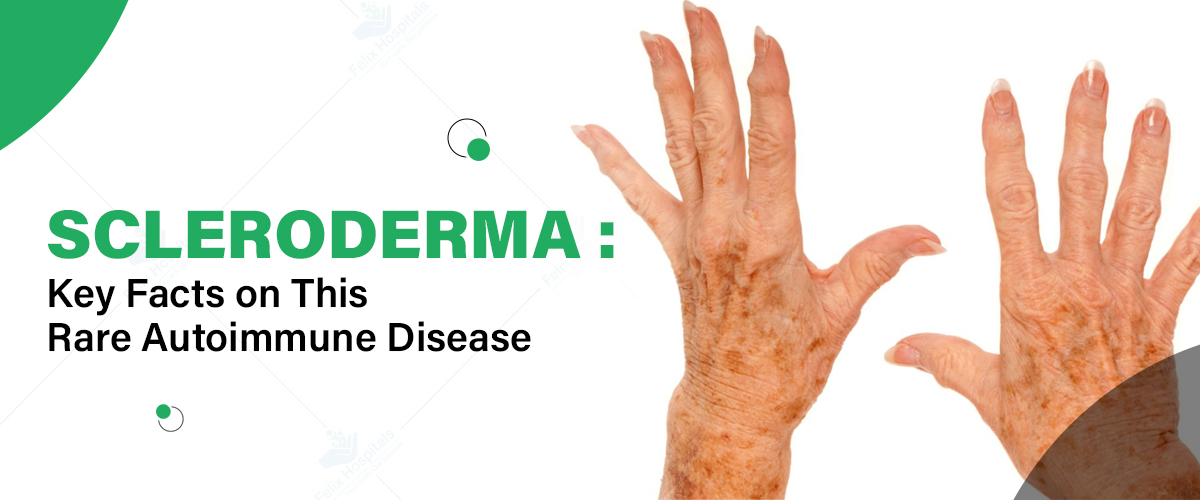
Subscribe to our

Scleroderma is a rare and complex autoimmune disease that affects the skin and connective tissues. Though it may start with mild symptoms, this condition can progress, potentially leading to severe complications. Understanding scleroderma, its symptoms, causes, and available treatments is essential for managing the disease effectively. If you're searching for expert care, Felix Hospitals offers specialized rheumatology services to help manage autoimmune diseases like scleroderma. As one of the best rheumatology hospitals in India, Felix Hospitals provides top-tier care for patients with complex conditions like scleroderma.
Schedule a Consultation with a Rheumatologist at Felix Hospitals Today! Call us Today at +91 9667064100.
Scleroderma, derived from the Greek words "sclero" (hard) and "derma" (skin), means "hard skin." It is an autoimmune disease that causes the immune system to attack healthy tissues, resulting in the hardening and tightening of the skin and connective tissues. Scleroderma can be localized, affecting only the skin, or systemic, impacting internal organs such as the lungs, heart, kidneys, and digestive system.
This disease is rare, and its severity varies widely from person to person. While scleroderma can be managed, early diagnosis and treatment are crucial for improving quality of life.
The symptoms of scleroderma can vary depending on whether the condition is localized or systemic. Common symptoms include:
Since scleroderma symptoms can mimic those of other autoimmune diseases, proper diagnosis is crucial for effective treatment.
The exact cause of scleroderma is still unknown, but it is believed to result from a combination of genetic, environmental, and immune system factors. Some key points about the causes include:
Understanding the potential causes can help patients take preventive measures, although there is no guaranteed way to prevent the disease entirely.
Diagnosing scleroderma can be challenging because its symptoms often overlap with those of other autoimmune diseases. A combination of clinical evaluation, imaging, and laboratory tests is typically used to confirm the diagnosis. Common diagnostic methods include:
An early and accurate diagnosis is essential for managing symptoms and preventing complications.
While there is no cure for scleroderma, various treatments are available to manage its symptoms and slow disease progression. The treatment plan is personalized based on the type of scleroderma and the severity of symptoms. Common treatments include:
Regular physical therapy can help maintain joint flexibility and prevent contractures in patients experiencing skin tightening and joint stiffness.
Patients are often advised to use emollient creams to keep their skin hydrated and reduce discomfort caused by dry, tight skin.
Depending on the organs involved, treatments may include medications for lung disease, high blood pressure, or kidney problems.
In rare cases, surgical intervention may be required to address severe complications, such as lung transplantation or removal of calcium deposits.
Patients are encouraged to adopt healthy habits, such as quitting smoking, managing stress, and engaging in regular exercise to improve overall well-being.
By working closely with a rheumatologist, patients can develop a comprehensive treatment plan to manage their condition effectively.
Since the exact cause of scleroderma is unknown, there are no guaranteed ways to prevent the disease. However, certain steps may reduce the risk of triggering an autoimmune response or worsening symptoms. These include:
Regular Medical Checkups: Early detection and management of symptoms are essential for preventing complications. Patients with a family history of autoimmune diseases should consult a rheumatologist for regular monitoring.
At Felix Hospital, we offer the best care for autoimmune diseases like scleroderma. Our team of experienced rheumatologists, including Dr. Kiran Seth specialize in diagnosing and managing complex autoimmune conditions. With access to the latest diagnostic tools and treatments, Felix Hospital ensures that patients receive personalized care tailored to their specific needs.
Book an Appointment with a Rheumatologist at Felix Hospitals Today by Clicking Here.
Scleroderma is a rare but serious autoimmune disease that can affect multiple organs and tissues in the body. While there is no cure, early diagnosis, and proper management can significantly improve a patient’s quality of life. Understanding the symptoms, causes, and treatment options allows individuals to take proactive steps toward better health. At Felix Hospital, our expert rheumatologists are dedicated to providing top-notch care for patients with scleroderma, helping them lead healthier and more fulfilling lives.
1. Is scleroderma a fatal disease?
Ans: Scleroderma is not necessarily fatal, but its complications, particularly those affecting internal organs, can be life-threatening if not managed properly.
2. Can scleroderma be cured?
Ans: There is no cure for scleroderma, but treatments are available to manage symptoms and slow disease progression.
3. How is scleroderma diagnosed?
Ans: Diagnosis involves a combination of physical examinations, blood tests, imaging studies, and sometimes a skin biopsy.
4. What are the early symptoms of scleroderma?
Ans: Early symptoms include hardening and thickening of the skin, Raynaud’s phenomenon, and joint stiffness.
5. What organs are affected by systemic scleroderma?
Ans: Systemic scleroderma can affect the lungs, kidneys, heart, digestive system, and skin.
6. How is scleroderma treated?
Ans: Treatment includes medications, physical therapy, skincare, and sometimes surgery, depending on the severity of the disease.
7. Is scleroderma hereditary?
Ans: Scleroderma is not directly inherited, but a family history of autoimmune diseases may increase the risk of developing the condition.
8. Can lifestyle changes help manage scleroderma?
Ans: Yes, quitting smoking, managing stress, and adopting a healthy lifestyle can help improve symptoms and overall well-being.
9. How can I find the best rheumatologist for scleroderma treatment?
Ans: Look for a rheumatologist with experience in treating autoimmune diseases, such as the specialists at Felix Hospital, who offer personalized and expert care.